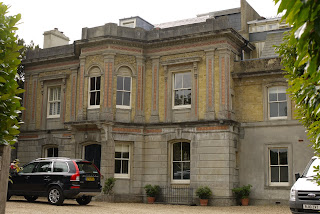Worborrow Bay from Flower's Barrow
We decided to carry on where we left off yesterday at Flower's Barrow. Our circular walk approach to the SWCP meant that essentially we had to do a there-and-back walk from Lulworth Cove, as there was no other sensible start point and a very limited choice of alternative paths.
We set off from the tourist car park and walked down the sloping street to the Cove itself, taking the stairs on the left to climb the hill above the cove. At the top we headed on up the very steep hill to find the start of the path which follows the ridge parallel to the coast. This chalky hill is a fine butterfly site and we saw several Chalkhill and Adonis Blues.
Soon we entered the Army Ranges, noticing as we did two squaddies with massive backpacks who were presumably out on some sort of punishment run.
We headed along the stony, chalky track past what seemed to be a massive TV aerial, enjoying fine views to the north and, from this point on, the sight of a tremendous sweep of coastline from St Aldhelm's Head in the east to Swyre Head and Portland in the west. To the left, inland, the Lulworth Army camp and training ground stretched out with a large network of tracks and sundry wrecked and rusty tanks scattered across it.
We walked along the top of Bindon Hill, with the long slope leading up to Flower's Barrow all too visible in front of us. We saw a number of Wall Browns here basking in the sunshine.
We thought the ridge continued all the way, but first there is a steep descent to Arish Mell at sea level. The little beach here is closed and a crew of workmen doing something with what seemed to be an outlet of some sort. A Google search yielded a suggestion that there was once an outlet here from the Winfrith Atomic Energy Establishment. So perhaps it is being repaired.
On the other side, a long winding slope led steeply up to Flower's Barrow. Once we were there, the view back along the coast was superb.
Now we began this leg of the Coast Path in the correct direction! Walking down the long slope was actually more taxing than climbing it had been. The toes and knees complained loudly. Then it was straight back up the other side to the ridge leading to Bindon Hill.
The views forward over Mupe Bay, with Mupe Rocks behind were very fine.
As we descended Bindon Hill towards Mupe Bay, the chalk cliffs provided an impressive sight along the coastline.
At the bottom, we went to the corner of the small bay housing Mupe Rocks and puzzled over the extraordinary angle at which the strata of rock were pointing.
There was now a flat section along a grassy cliff-top path overlooking the Fossil Forest. This is a literal description rather than a fanciful one. 144m years ago there was a forest here which was flooded under a shallow, saline lagoon. Thick mats of algae grew across the forest floor and around the base of the trees and fallen logs. Sediment stuck to the this and built up over time to form the large doughnut-shaped rings that can be seen today around the trees and wood.
At the end of this section you reach the mouth of Lulworth Cove, with Portland and Weymouth in sight beyond.
We climbed the long sequence of steps to the side of the cove and walked along the lower path at the top enjoying a fine view of the cove.
Then it was down the path and steps on the other side to walk back up the lane to the car - via a well-deserved drink in a bar on the way.
Conditions: sunny, hot.
Distance: about 7 miles, of which only 3 were on the Coast Path. Distance covered now 28 miles.
Map: Explorer OL15 (Purbeck and South Dorset).
Rating: four and a half stars.
Reflections
The walk took us far longer than a walk of this length normally would. Obviously this was due to the five steep climbs or descents that it included - and the consequent rests that they entailed. It led us to think that we need a better way of estimating the time required for this sort of walk and I remembered my friend John once saying that with Alpine walking the total change of height was often a better predictor of time taken than the linear distance. In this case the eight climbs/descents amounted to over a kilometer of change of level.
Secondly, I realised that I still need to improve my map-reading skills in order to identify all these changes in advance, rather than be surprised by them.
When we looked in the SWCP Handbook we were delighted to see that the Lulworth to Kimmeridge section was rated "Severe" - the highest rating on a scale starting at "Easy". Who would have thought we could have handled Severe without any great difficulty?
















































